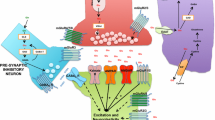Summary.
Based on 1) neuroanatomical and neuroimaging studies indicating aberrations in brain regions that are rich in glutamate neurons and 2) similarities between symptoms produced by N-methyl-D-aspartate (NMDA) antagonists in healthy subjects and those seen in autism, it is proposed in the present paper that infantile autism is a hypoglutamatergic disorder. Possible future pharmacological interventions in autism are discussed in the light of the intimate interplay between central glutamate and serotonin, notably the serotonin (5-HT) 2A receptor. The possible benefit of treatment with glutamate agonists [e.g. agents acting on the modulatory glycine site of the NMDA receptor, or so-called ampakines acting on the α-amino-3-hydroxy-5-methyl-4-isoxazole propionic acid (AMPA) receptor] is discussed, as well as the potential usefulness of a selective 5-HT2A receptor antagonist.
Similar content being viewed by others
Author information
Authors and Affiliations
Additional information
Accepted February 4, 1998; received December 10, 1997
Rights and permissions
About this article
Cite this article
Carlsson, M. Hypothesis: Is infantile autism a hypoglutamatergic disorder? Relevance of glutamate – serotonin interactions for pharmacotherapy. J Neural Transm 105, 525–535 (1998). https://doi.org/10.1007/s007020050076
Issue Date:
DOI: https://doi.org/10.1007/s007020050076




